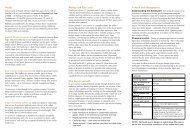Bushland Weeds Manual - Environmental Weeds Action Network
Bushland Weeds Manual - Environmental Weeds Action Network
Bushland Weeds Manual - Environmental Weeds Action Network
You also want an ePaper? Increase the reach of your titles
YUMPU automatically turns print PDFs into web optimized ePapers that Google loves.
44<br />
Chapter 4 Corms, Bulbs and Tubers Case Studies<br />
Case study 4.1 Managing the spread of Yellow Soldier (Lachenalia reflexa)<br />
in a Banksia woodland<br />
Yellow Soldier (Lachenalia reflexa).<br />
This study investigated the<br />
effectiveness of hand-removal and<br />
two herbicide treatments on the<br />
control of Yellow Soldier<br />
(Lachenalia reflexa). Trials took<br />
place in the species-rich<br />
Banksia/Jarrah woodland in<br />
Shenton <strong>Bushland</strong>. The impact of<br />
each treatment on the native flora<br />
was also recorded.<br />
Carefully hand-removing Yellow Soldier in<br />
Shenton <strong>Bushland</strong>.<br />
Measuring cover of all species<br />
in treatment plots<br />
The ‘point quadrat’ method<br />
(Bonham 1989) was used to<br />
determine percentage-overlapping<br />
cover (referred to as cover) for all<br />
species using 200 points within<br />
each plot (2 m x 2 m). There were<br />
five replicates of each treatment.<br />
Effectiveness of treatments<br />
Hand-removal (1998 & 1999) over<br />
two seasons left all natives intact<br />
but was very labour intensive,<br />
reducing cover of Yellow Soldier by<br />
only 44 %. It also triggered<br />
germination of annual weeds.<br />
Wiping the leaves (1998) of<br />
individual plants with a 10 %<br />
glyphosate solution was not<br />
effective and was also very labour<br />
intensive.<br />
Spot spraying (1999) with<br />
metsulfuron methyl at 0.2 g/15 L (5<br />
g/ha) reduced the cover of Yellow<br />
Soldier by 65 % in one season and<br />
appeared to have no significant<br />
impact on native shrubs or herbs<br />
including native geophytes.<br />
The control (do nothing) Yellow<br />
Soldier increased in cover by over<br />
30 % between 1998 and 2000.<br />
Percentage cover<br />
55<br />
50<br />
45<br />
40<br />
35<br />
30<br />
25<br />
20<br />
15<br />
10<br />
5<br />
control<br />
hand removal<br />
herbicide<br />
1998 1999 2000<br />
Year<br />
Figure 1. Cover of Yellow Soldier in control,<br />
hand-removal and herbicide treatment plots<br />
in 1998,1999 and 2000. The bars indicate<br />
standard errors.<br />
Impacts on natives<br />
The herbicide treatments did not<br />
significantly affect native shrubs or<br />
perennial herbs, with both groups<br />
increasing in cover in the treatment<br />
plots over two years. Although the<br />
impacts of the metsulfuron<br />
treatment on native geophytes<br />
appeared not to be significant it was<br />
difficult to assess. There was a large<br />
variation across the trial sites in<br />
both cover (which is naturally low),<br />
and in species. Of the eight species<br />
present only one, Milkmaid<br />
(Burchardia congesta), was present<br />
in all 15 plots. Leafy Sundew<br />
(Drosera stolonifera), Vanilla Lily<br />
(Sowerbaea laxiflora), Climbing<br />
Fringe Lily (Thysanotus<br />
manglesianus), and Haemodorum<br />
spp. were present in most plots<br />
with Pale Grass Lily (Caesia<br />
micrantha) and Red Beak Orchid<br />
(Pyrorchis nigricans) occurring only<br />
occasionally.<br />
Percentage cover<br />
15<br />
10<br />
5<br />
0<br />
control<br />
hand removal<br />
herbicide<br />
1998 1999 2000<br />
Year<br />
Figure 2. Cover of native geophytes in<br />
control, hand-removal and herbicide<br />
treatment plots in 1998, 1999 and 2000.<br />
The bars indicate standard errors.<br />
Implications for management<br />
Yellow Soldier still comprised 12 %<br />
of cover in 2000 therefore indicating<br />
that any broad scale application<br />
would need to be carefully followed<br />
up for a number of years following<br />
initial application to ensure reinvasion<br />
does not occur.<br />
In the species-rich Banksia<br />
woodland at Shenton <strong>Bushland</strong>,<br />
Yellow Soldier co-occurs with up to<br />
25 native species in a 2 m x 2 m plot



